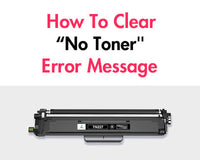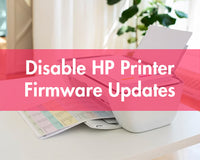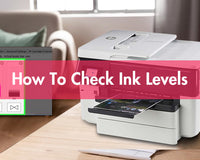Let’s be honest — setting up printers can be a bit of a headache. Between tangled cables, confusing drivers, and trying to connect over Wi-Fi. That’s where NFC printers come in to save the day. In this blog, we’ll take a closer look at what an NFC printer is and why it might be the smarter choice for busy users.
Table of Contents:
- What Is NFC?
- What Is an NFC Printer?
- How Does an NFC Printer Work?
- Advantages of NFC Printer
- Disadvantages of NFC Printer
- How to Use an NFC Printer
- Troubles above an NFC Printer
- Conclusion
What Is NFC?

Before knowing about NFC printers, we need to figure out what NFC is. NFC, the full name of which is Near Field Communication. It sounds high-tech, but you probably already use it every day without noticing it. Do you swipe your bus card or subway card? That's NFC. Some access cards and door locks that open with a touch? That's right, NFC.
Its biggest feature is "touch and connect immediately". You don't need to enter a password, pair devices, turn on Bluetooth, or connect to Wi-Fi. This is why more and more devices, including printers, use NFC.
What's the difference between NFC and Bluetooth, and Wi-Fi?
|
Function |
NFC |
Bluetooth |
Wi-Fi |
|
Connection method |
Just touch |
Turn on the device, search, and pair |
Connect to the network and enter the password |
|
Speed |
Fast connection and average transmission speed |
Medium speed |
Fast speed and suitable for transferring large files
|
|
Distance |
Very close |
A few meters |
Tens of meters or even hundreds of meters |
|
User experience |
Most convenient and lazy-friendly |
Requires a little setting |
Slightly complicated to set up
|
NFC is not intended to replace Bluetooth or Wi-Fi, but to allow you to connect faster and more simply in certain scenarios, such as printing a document, scanning a code to pay, and quick authentication.
What Is an NFC Printer?
You may have guessed it by now. Since access cards and bus cards can be operated by "touch and tap", can printers be used in this way? Yes, this is the NFC printer we are going to talk about today.
The NFC printer is a printer with a built-in NFC function. It allows you to start printing by directly approaching the printer with your device. You don't need to plug in a cable, pair Bluetooth in advance, or mess around with complicated wireless settings. It's as simple as swiping your bus card. As long as your device supports NFC, you can connect to the printer with just a touch. You can easily print out photos and documents.
Imagine you are in an office or a coffee shop, just turn on your phone and gently touch the printer. A clear document is printed out. Isn't it much more worry-free than traditional printing methods?
How Does an NFC Printer Work?
So, how does an NFC printer work? The process behind it can be understood like this:
The NFC printer has a built-in NFC function. The NFC function can perform proximity sensing. When your phone is close to the printer, the two with NFC function will start to recognize each other’s identity. As long as the distance is close enough, they can instantly recognize each other. Then the phone will automatically start the wireless connection between it and the printer.
For example, if there is no NFC, you have to manually connect to Wi-Fi, find the printer, and enter the password in the settings. It is very troublesome. But NFC is like a switch. It will help you complete these steps automatically with one touch.
Next, the files or photos you want to print on your phone will be sent directly to the printer through a wireless channel. A few seconds later, the printer starts working.
How to Use an NFC Printer
Step 1: Confirm that your device supports NFC
You can search for "NFC" in your phone's settings to see if you can turn on this feature.

Step 2: Turn on NFC and the printer
- Turn on the NFC feature on your phone.
- Turn on the printer and make sure it supports the NFC feature. Generally, the NFC area is on the top panel of the printer.

Step 3: Touch your phone to the printer
- You need to gently touch the NFC area on the back of your phone to the NFC area of the printer.
- If the connection is successful, a prompt will automatically pop up on your phone, such as "Do you want to connect to the printer," or "Do you want to print photos.";
- You just need to click "Confirm" to enter the print page.


Step 4: Choose what you want to print
- After the connection is successful, you can choose:
- Print photos in your phone; print PDF files, documents, web pages, etc..
- Some brands (such as HP, Canon) will also jump to their apps for operation, and the interface will be clearer.
Step 5: Click "Print" and you're done!
You can preview the print result and select paper, size, color mode, and more. Then you can click "Print" after confirming that everything is OK. After a few seconds, the printer will start working. It's very simple.
Troubles above an NFC Printer
|
Situation |
Solution |
|
The phone does not respond when touched |
Check if NFC is turned on; change the angle to fit |
|
The phone does not pop up |
Download the official App of the printing brand and try it |
|
Printing failed |
Maybe the printer is not connected to the Internet. Restart it and see |
Advantages of NFC Printer
Have you ever tried to print a document and ended up struggling for a long time? You have to connect to Wi-Fi, download drivers, figure out the printer model, and ask for passwords... NFC printers can save you almost all these steps. Let's take a look at its thoughtful benefits:
1. Just touch and print - worry-free
You don't need to know the technology or set up any network. As long as your phone has an NFC function, you can print directly by touching it close to the printer.
2. Automatic connection, no need to set up again every time
For ordinary printers, sometimes you connect once and can't find it the second time. You may have to reconfigure the network. But NFC printers, once you touch them, they will remember you. Next time you get close to it, it will automatically connect.
3. Support mobile office and can be used on business trips and stalls
Do you often work outside? For example, running a business, setting up a temporary stall, or attending exhibitions?
With an NFC small printer, you can only bring a mobile phone and a portable printer. No matter where you are, you can print whenever you want. You don't have to connect to a computer on-site. It is very easy and hassle-free.
4. Higher security, fewer misoperations
NFC is "close-range" sensing. So the connection will only be triggered when your phone is really close to the printer. It is not as easy to be misconnected or send files randomly as Wi-Fi.
5. No need to install complex drivers
Traditional printers require different versions of drivers to be installed when changing phones or systems. NFC printers often support "plug and play". You just need to turn on the NFC function or print directly with the App. This saves a lot of trouble.
Disadvantages of NFC Printer
We talked about many advantages of NFC printers above. But nothing is perfect, and the same is true for NFC printers. Although it is convenient, it also has some minor disadvantages. Let's talk about them:
1. Does the mobile phone not have NFC? Can't use it directly
Although many mobile phones have an NFC function, not every mobile phone has it. If your mobile phone does not have an NFC function, then this printer is the same as a normal printer. It loses the convenience.
2. Limited device compatibility, sometimes not necessarily an "instant connection"
Sometimes there are compatibility issues between mobile phones and printers of different brands and models.
For example, some mobile phones cannot recognize printers of certain brands, or need to install apps before printing.
3. NFC can't do it all.
NFC printers are convenient, but they do not necessarily print quickly and clearly. Especially for some portable models, they may just be used to quickly output basic documents or labels. If you care about print quality, like color printing, resolution, or double-sided printing, then you need to check the specific model — having NFC alone isn’t enough.
4. The price may be a bit higher
Printers with NFC functions tend to be more expensive.
5. Cannot completely replace Wi-Fi or Bluetooth connection
Usually, NFC is used to quickly trigger a Bluetooth or Wi-Fi connection. If the Wi-Fi signal in the environment is not good, or the printer's network is unstable, you may still not be able to print out the file.
Conclusion
NFC printers aren’t just another tech buzzword — they’re an efficient solution. If you’re constantly printing from your phone, juggling between work and personal tasks, or just tired of tech headaches, an NFC printer might be exactly what you need.
Of course, like any technology, NFC printers aren’t perfect. They may not suit everyone, especially if you’re looking for high-end print quality. But for NFC phone users who value speed and convenience, they’re worth a look.












